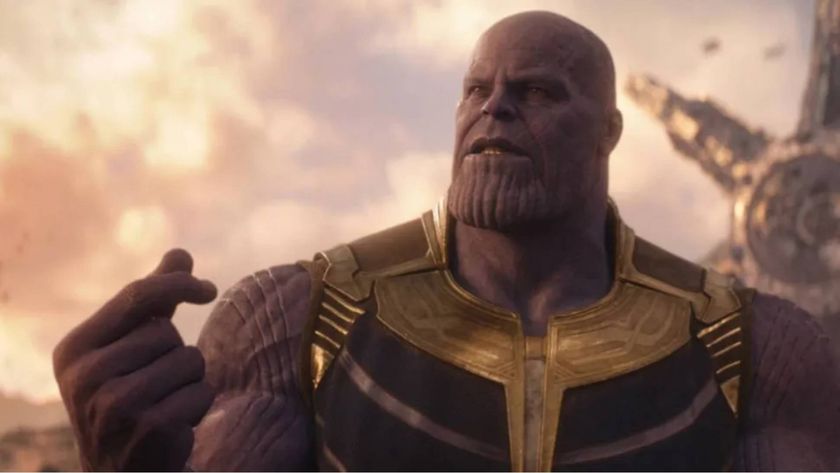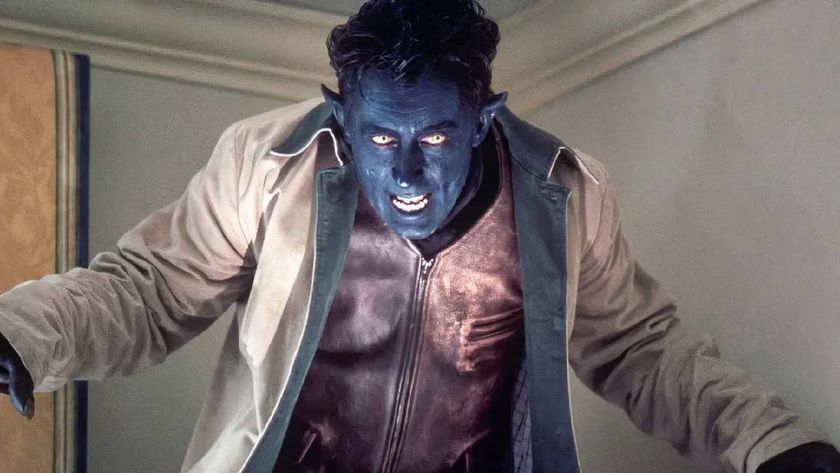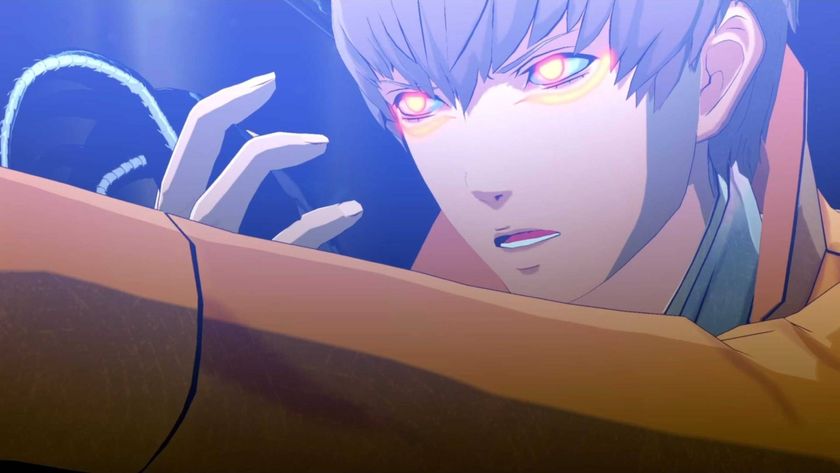Way back in early 1969, a minor superhero team turned up for an issue of Marvel Super-Heroes. In the summer of 2014, after disappearing and regrouping on and off for over 40 years, they suddenly became the biggest news in pop culture. By far Marvel's most ridiculous and spectacular nobodies-become-somebodies story has been enjoyed by the Guardians Of The Galaxy. How did they get from there to here?
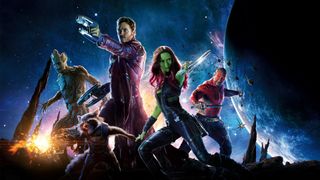
A deep-space, initially far-future team of aliens and renegades originally created by such minor players as Arnold Drake for a near-forgotten part-reprint title in 1968, they enjoyed only spluttering success over the following decade before disappearing, seemingly forever. Yet somehow a big-budget movie starring these guys, a bunch of oddballs virtually unknown outside the comic shops, became a modern phenomenon. The Blu-ray and DVD of Guardians Of The Galaxy were released last month in the UK and in December in the US, so here's our recap on their comic origins...
Earth Shall Overcome!
Fans of the original Guardians Of The Galaxy – and it certainly has some – would be hard pushed to recognise anything of their heroes in the current incarnation. The first team launched in Marvel Super-Heroes #18 (January 1969) as Robin Hood-type rebels against an evil 31st century Badoon empire. These man-reptile tyrants – originally created by Stan Lee and John Buscema for their glorious, short-lived late ’60s Silver Surfer title – conquered Earth and its colony planets across the Solar System.
Both this future timeline – later dubbed Earth-691 in the language of Marvel’s Alan Moore-created, Michael Moorcock-influenced Multiverse – and the core Guardians characters were created by Arnold Drake (a DC writer best known for co-creating Deadman and Doom Patrol, who briefly freelanced at Marvel in the late ’60s) and artist Gene Colan. Their leader, originally, was Major Vance Astro, a young astronaut from the 20th century who was sent on a lone, Buck Rogers-type mission into deep space. Lacking faster-than-light tech, his ship would take 1,000 years to reach Earth’s nearest star, Alpha Centauri, and to keep him alive all that time he was injected with some sort of embalming fluid-type artificial blood, encased in a metal second skin and chucked into suspended animation.
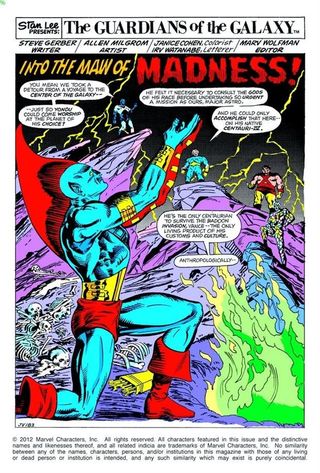
Except, of course, that when he eventually reached his destination, now with psionic powers that had developed in hibernation, he found a recently FTL-equipped humanity had already got there, and was now living peacefully side-by-side with the blue-skinned native tribesmen. When the Badoon attack – first Centauri IV, then mankind’s Solar System colonies and finally Earth itself – Astro teams up with Centauri bowman Yondu and the last surviving members of two genetically modified human sub-species to bring the fight to the Badoon. Charlie-27 is wide as a house, massively strong, and was created to live under the oppressive gravity of Jupiter, while Martinex is from Pluto, and comes covered with a sort of silicon crystalline skin to help him survive the extreme temperatures there; both, naturally, are good in a fight.
The Power Of Starhawk
Sign up to the SFX Newsletter
Get sneak previews, exclusive competitions and details of special events each month!
But hang on, you might be saying. What’s all this? No Rocket Raccoon? No walking trees? Indeed not. And there wouldn't be for decades yet.
Following their debut, the Guardians disappeared for five years, only to be eventually rescued by Steve Gerber, Marvel’s quirkiest writer of the day, for Marvel Two-In-One, and, following that, his mid-’70s Defenders run. The Defenders #26 (August 1975) is the key issue here, detailing the future history of Earth in chilling, fascinating fashion for a mainstream Marvel audience, while the following issues whisk Dr Strange, Hulk, Valkyrie and co to the Guardians’ nightmarish 3007, there to take the fight to the Badoon and enjoy a first encounter with a powerful, arrogant so-and-so called Starhawk, a character that had been promised since as far back as Marvel Super-Heroes #20, but who’d never showed up (bar a brief appearance in Marvelmania, short-lived in-house Marvel fanzine) until now.
Not to be mistaken for the modern Star-Lord – the entertaining, charming, troubled jerk of the present-day Guardians – this guy was a cold and remote mystery man in the Silver Surfer mould, his story unfolding over the subsequent 1970s Guardians appearances. These were in scattered issues of books like The Avengers, but chiefly in their own intriguing, rather out-there 10-issue 1976-77 run in Marvel Presents (yet another short-lived try-out title), by Gerber and artist Al Milgrom.
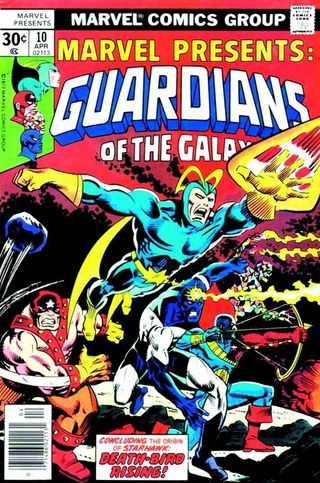
This series introduced the last of the original members – Nikki, a genetically-modified woman from Earth’s Mercury colony, good with a gun and boasting flames instead of hair – and explored Starhawk’s half-human, half-artificial character: an arch-manipulator, powered to outrageous levels by an alien Hawk God, and doomed to relive his own life countless times.
In truth, Gerber’s run on Guardians wasn't one of his most virtuoso jobs, but it was not without its memorable moments. The “Planet Of The Absurd” issue – in which the Guardians explore a world highly reminiscent of gangster-era New York – was played like a bizarro Star Trek episode, and enjoyed a title that seemed to sum up Gerber’s whole approach to life and to comic books; the stories that revealed Starhawk to be effectively transgender, a man and a woman – adopted siblings and lovers – merged into one was something of a stunner too.
Sex In Space
And this Guardians run also featured the first blatant act of sexual intercourse in a Comics Code-approved superhero book, in which Vance Astro and Nikki do it – in disguised form. In order to destroy the Topographical Man (a planet-size humanoid energy vampire who fed on exploding galaxies) Vance’s psyche was absorbed by their enemy and started to control its consciousness; meanwhile, Nikki was strapped into a gizmo that split her spirit from her body, and her astral form went to communicate with the big fella.
Hot-blooded Nikki saw the best way forward was not chat but coitus, something Vance was well up for, as the sexual tension had been unbearable on the Guardians’ ship (a USS Enterprise-knockoff called, bizarrely, Captain America) up until then. Soon a grinning astral-Nikki “reaches gently out, to awaken him with her touch” then clearly mounts him, “in order that, acting in concert, they might destroy him forevermore”. The Topographical Man is then ripped apart in an explosion clearly centred on his crotch, caused because he, or it, had been forced to “engage in an act of love, an affirmation of its own opposite, which is life”.
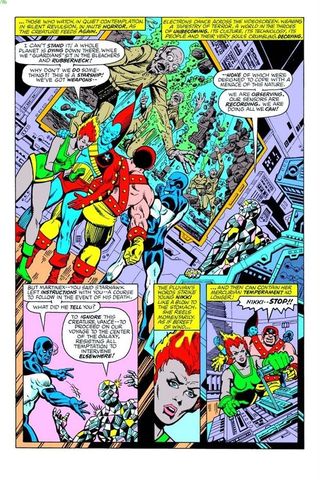
It was amazing stuff – amazing that the Comics Code let it slide – but perhaps the prosaic, unsexy “it’s just regular superheroes” art of Milgrom (as with Sal Buscema’s similarly generic stuff on Gerber’s Defenders issues of the time) helped sell it; Guardians, like much of Gerber, was a far weirder comic than it appeared to be on the surface.
Eventually these Guardians would defeat the Badoon, return numerous times to 20th century Earth – not least to help the Avengers against Korvac in one of the all-time great Marvel storylines – and then fade away for many years, to be revived for a brand new, surprisingly enduring ’90s series by writer-artist Jim Valentino, then one of Marvel’s rising stars. His take on the Guardians lasted a creditable 62 issues across the first half of the ’90s, the team now shooting about in Captain America – named, of course, for the legendary hero – as self-appointed protectors of the Milky Way; literally, as “Guardians of the Galaxy”. Future-versions of existing Marvel heroes would crop up relentlessly – we get 31st century descendants of Ghost Rider, Iron Man, Doctor Doom, Galactus, Silver Surfer, Wolverine – and it’s here that Vance Astro decides, ludicrously, to rename himself Major Victory.
This take on the Guardians is a consistently average series, really; but it was produced in a so-so approximation of the then-trendy West Coast style of Todd McFarlane, Jim Lee and others, and it would see Valentino become part of their cocky, ambitious gang. When the entire lot of them up-sticked to found Image, Valentino was part of it, contributing to the new company a borderline tasteless grim vigilante called Shadowhawk. This take on Guardians limped on without him for a while, however, but by 1995 it was all over – and the team would stay out of the limelight for over a decade.
So that’s a good quarter century of the Guardians Of The Galaxy without a whiff of talking beasts or walking trees. What in the universe could happen to see their star rise so brightly, so quickly, in the decades since?
A New Team Will Rise…
The answer comes with the 2006 revival of interest in Outer Space Marvel that arrived with Annihilation, an epic crossover series written by Keith Giffen which was built of bookend issues plus miniseries for the Silver Surfer, Nova and a number of cosmic villains: Thanos, Drax the Destroyer, Super-Skrull and Ronan the Accuser. Both Star-Lord and Thanos’s adopted daughter, Gamora, crop up too, and when the British writing team of Dan Abnett and Andy Lanning took over for a sequel, Annihilation: Conquest, the modern day gang started to come together.
This time out Star-Lord had his own miniseries as part of the “event”, Groot and Rocket Raccoon join the fray, Starhawk popped up (after teleporting himself back from his far-future timeline, appearing as both a man and a woman) along with virtually every other space hero or villain the creative team could think of, and the whole thing ends with a plan to create a new outfit to prevent such deep space catastrophes from ever happening again. Thus was born the new Guardians Of The Galaxy – inspired by the original Guardians, but largely unconnected to them – with an initial line-up of Star-Lord, Quasar, Adam Warlock, Drax the Destroyer, Gamora, sentient extra-terrestrial tree Groot and, yes, Rocket Raccoon: a comedy, Beatles-inspired, talking, gun-toting forest-dwelling mammal.
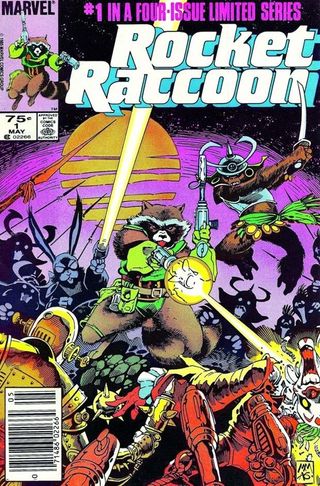
It was weird alright, but then the Guardians had ever been so. Rocket had been created by Bill Mantlo and Keith Giffen as a not-too-serious tribute to the cowboy-themed spoof folk song Rocky Raccoon from The Beatles’ White Album; he’d first appeared in Marvel Preview in 1976, became a Hulk supporting character for a while, and had enjoyed his own four-issue miniseries in 1985.
I Am Groot
Groot had begun life in 1960 as an example of the slew of alien monstrosities attempting Earth invasion in Stan Lee and Jack Kirby’s Tales To Astonish, one of the many monster books published by Marvel before it became the company we know with the launch of the Fantastic Four. Pre-Guardians he’d only reappeared very occasionally, in the odd Hulk or Spider-Man book, before a minor 2006 revival as part of Nick Fury’s Howling Commandos – an unsuccessful miniseries that attempted to weld Marvel’s secondary supernatural characters to the super-spy agency. Drax and Gamora, meanwhile, had always been as much villain as hero.
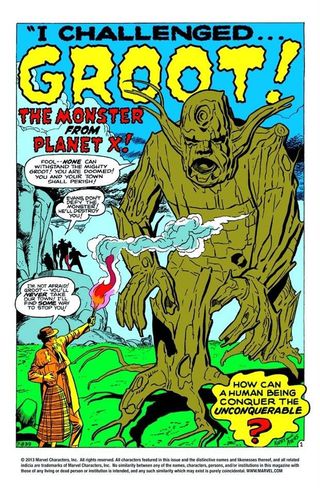
The new Abnett and Lanning Guardians book launched in May 2008 – alongside a new, linked Nova series, from the same writers – but wasn't a massive hit, lasting just 25 issues. However, it clearly had an audience, admirers, and potential. The new team would now echo the early career of the original Guardians, appearing as guests in other books and in a number of crossovers (War Of Kings, The Thanos Imperative), shedding members and adding new ones. By the end, people like Mantis, Major Victory, Jack Flag, Bug from the Micronauts and even a talking dog called Cosmo were members, while Drax and Star-Lord were both dead.
With the arrival of Marvel NOW! in late 2010, however, the Guardians got another bite at the cherry, this time handled by the all-star creative team of writer Brian Michael Bendis and artist Steve McNiven, and it’s this version we get in the film – Peter Quill, aka Star-Lord, half-human space adventurer, was alive and well, and very much the snarky, roguish action hero we see in the film, with Drax, Gamora, Rocket and Groot the key supporting cast. It’s a book that sings when the characters are all together, bouncing off each other and verbally sparring, and feels like it’s treading water when they often get spread across known space.
Now one of the Big Bads would be Peter Quill’s alien father, space dictator from a powerful human-looking alien species called the Spartex – their relationship has become very Luke-and-Vader over the past few years, with Pops wanting Pete to join him in ruling the galaxy – while the Badoon are back, as are further unsavoury space species like the Giger’s Alien-referencing the Brood from old X-Men comics. Iron Man has arrived on the team and departed again, Neil Gaiman’s old Angela character from Spawn made an appearance, the Carol Danvers Captain Marvel is kicking around, and Agent Venom (none other than Flash Thompson, Peter Parker’s high school nemesis-turned-pal from ’60s Spider-Man) is now a Guardian too. Some of the connections being made here are crazy, some logical as you like – but hey, that’s Marvel for you. It's a fun, handsome title and is still ongoing, if, having caught this year's movie, you'd like to carry on with our heroes' adventures in pen-and-ink form…
Marvel's 2014 blockbuster adaptation of Guardians Of The Galaxy is available on Blu-ray and DVD now in the UK and from Tuesday 9 December in the US. A version of this article first appeared in Comic Heroes magazine issue 24 written by Matt Bielby.
SFX Magazine is the world's number one sci-fi, fantasy, and horror magazine published by Future PLC. Established in 1995, SFX Magazine prides itself on writing for its fans, welcoming geeks, collectors, and aficionados into its readership for over 25 years. Covering films, TV shows, books, comics, games, merch, and more, SFX Magazine is published every month. If you love it, chances are we do too and you'll find it in SFX.
